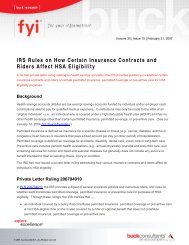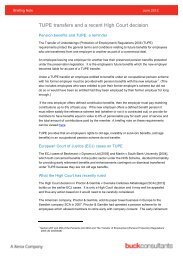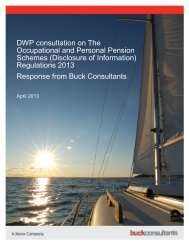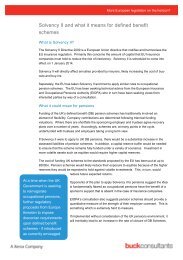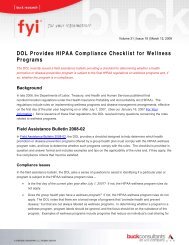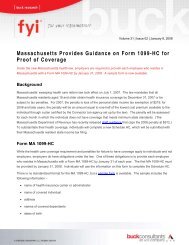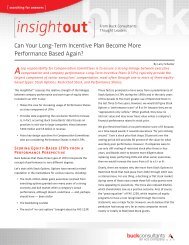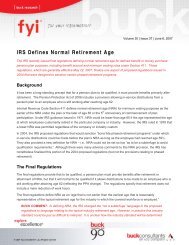Pensions News - Buckconsultants.com
Pensions News - Buckconsultants.com
Pensions News - Buckconsultants.com
You also want an ePaper? Increase the reach of your titles
YUMPU automatically turns print PDFs into web optimized ePapers that Google loves.
<strong>Pensions</strong> <strong>News</strong> – April 2013Table of Contents1. Recently implemented changes .............................................. 11) Automatic enrolment ................................................................................. 12) Pension incentive exercises ...................................................................... 13) Partial refunds of member contributions .................................................... 24) Industry code of practice on pension charges ........................................... 25) Miscellaneous amendments to defined benefit legislation ......................... 32. Forth<strong>com</strong>ing legislative and other changes............................. 41) Reductions on the lifetime and annual allowances .................................... 42) Consultation on simplifying the process of automatic enrolment ................ 53) Consultation on changes to the TUPE requirements for pensions.............. 54) Consultation on consolidated disclosure of information regulations ........... 65) Consultation on GMP equalisation ............................................................ 66) Reform of the State Pension system ......................................................... 67) Call for evidence on NEST restrictions ...................................................... 78) Consultation on changes to NEST ............................................................ 79) Considering the potential impact on pension schemes of a takeover ......... 83. Other current issues ............................................................... 91) Reinvigorating workplace pensions ........................................................... 92) DWP consultations concerning the <strong>Pensions</strong> Regulator ............................ 93) OFT investigation into DC schemes ........................................................ 104) <strong>Pensions</strong> liberation ................................................................................. 115) No change to the Retail Prices Index ...................................................... 116) Improving transfers and dealing with small DC pension pots ................... 117) Solvency II/IORP Directive ...................................................................... 128) NAPF Annual Survey 2012 ..................................................................... 124. Recent <strong>Pensions</strong> Regulator publications .............................. 131) Consultations ......................................................................................... 132) Definitive guidance ................................................................................. 145. Recent Pension Protection Fund (PPF) publications ............ 161) Definitive guidance ................................................................................. 16Appendix – Summary of recent and impending changes ............. 18
<strong>Pensions</strong> <strong>News</strong> – April 20131. Recently implemented changes1) Automatic enrolmentThe automatic enrolment regime finally came into force (for the largest employers) on 1 October2012. Most of the detail is now confirmed, although no doubt certain issues will still require theattention of the Regulator and the DWP as the system beds in. Indeed, the DWP is consultingon proposals to make the process of automatic enrolment simpler (see section 2.2). Some ofthe main issues from the past few months are covered below.Staging datesThe timetable of staging dates (from when an employer’s automatic enrolment duties areintroduced) runs until April 2017, with new employers then having staging dates through to thestart of 2018.Earnings limitsReassuringly, the Government has aligned the rates for 2013/14 with the same limits andthresholds as it did for the previous tax year, and so achieves some consistency. A GovernmentOrder provides for:• An earnings trigger of £9,440. (This is higher than the figure originally consulted on toac<strong>com</strong>modate the Chancellor’s Autumn Statement announcement of a further increasein the personal allowance for in<strong>com</strong>e tax next year.)• A lower limit for the qualifying earnings band of £5,668 aligned with the 2013/14 lowerearnings limit for National Insurance contributions (NIC).• An upper limit for the qualifying earnings band of £41,450 aligned with next year’supper earnings limit for NIC purposes.2) Pension incentive exercisesIn June 2012 an Industry Working Group published a voluntary code of practice, to cover thevarious forms of incentives used by employers to ‘de-risk’ defined benefit (DB) liabilities,including enhanced transfer values and pension increase exchange exercises.The Code is intended to protect members with accrued rights in UK registered DB pensionschemes, where they are given an invitation or an inducement to change the form of theirpension. The Code is also designed to protect employers who may be at risk of futurechallenges from members disadvantaged by accepting an offer.The key objectives of the Code are to help ensure that all incentive exercises enable membersto make informed decisions and better choices, whilst permitting exercises and options to beoffered in a responsible manner, and that exercises are:• carried out fairly and transparently;• <strong>com</strong>municated in a balanced way and in terms that members can understand;1
<strong>Pensions</strong> <strong>News</strong> – April 2013• available with appropriate financial advice (or in some limited circumstances, financialguidance) that is paid for by the party initiating the exercise (typically the employer);• able to achieve high levels of member engagement; and• provided with access to an independent <strong>com</strong>plaints and <strong>com</strong>pensation process.The Code is made up of seven principles supplemented by information on how to apply thoseprinciples. In July 2012, the Regulator reissued its guidance on incentive exercises following thepublication of the voluntary code (see section 4.2).3) Partial refunds of member contributionsRefunds of contributions paid to members who leave pensionable service after less than twoyears must meet certain statutory conditions. This includes the requirement that the refund“…extinguishes the member's entitlement to benefits under the pension scheme (except to theextent that it is prohibited from being extinguished by the payment of a lump sum by reason ofthe operation of provision made by or under any enactment)”.On the abolition of protected rights in April 2012, the legislation preventing the refund ofprotected rights was repealed, and there is no longer any legal requirement to differentiatebetween protected rights and non-protected rights in a scheme.Trustees therefore need to decide whether or not a scheme’s rules permit the refund of rightsthat were protected rights until 5 April 2012. Where the rules of a scheme prevent protectedrights being paid out and the rules have not been amended to allow for the refund of a person’sentire rights as a SSRLS, trustees can no longer rely on the statutory exception referred toabove. Payment of partial refunds to exclude former protected rights would now beunauthorised payments.Regulations came into force on 8 August 2012 that permit schemes in this position to paypartial refunds as an authorised payment, as long as the refund meets certain otherrequirements. Draft amendments to clarify the operation of these regulations have beenconsulted on by HMRC.4) Industry code of practice on pension chargesIn response to the concerns raised about member charging, an industry code of conduct (theCode) has been produced to help employers understand the impact of charges when selectinga defined contribution (DC) pension scheme for automatic enrolment purposes. Going forward,providers of workplace pension schemes will be expected to disclose the charges that arelevied upon their products in a clear and consistent way.The Code looks to ensure that information about charges is presented in a consistent way tohelp employers understand the impact of fees on members’ pension pots and which chargesthey are liable for.It has three key elements.2
<strong>Pensions</strong> <strong>News</strong> – April 20131. All charges must be clearly and accurately stated in writing before an employerchooses a pension scheme.2. A standard template must be provided summarising the services that will be provided tothe employer.3. Clear examples of the effect of the charges on members’ pots must be disclosed.The Code is intended to apply to all parties providing services to the employers in establishingand administering schemes including the trustees of occupational pension schemes. It will haveeffect in two stages, starting from 1 January 2013.5) Miscellaneous amendments to defined benefit legislationRegulations came into force on 6 April 2013 that make a number of minor amendments toexisting legislation on defined benefit schemes.The regulations also make two changes to legislation affecting defined benefit schemes that are(or used to be) contracted-out. The amendments:• Clarify the policy intention in relation to schemes that have ceased to contract out andwish to make a change to their scheme rules.• Allow bulk transfers of scheme membership of contracted-out schemes to formerlycontracted-out defined benefit schemes without member consent, and allow bothcontracted-out and contracted-in schemes to make bulk transfer of scheme membershipto schemes which did formerly apply to employment with the same employer, but now nolonger do so.3
<strong>Pensions</strong> <strong>News</strong> – April 2013current earnings), which is above the basic level for means-tested support. Individuals will need35 years of National Insurance contributions (NICs) (or credits) to qualify for the full pension.The single-tier pension had been expected to be introduced from April 2017, but ahead of thisyear’s Budget, the Chancellor announced that it would in fact begin in 2016.The abolition of S2P means that contracting-out for defined benefit schemes will cease, and inlight of the Chancellor’s announcement, this will now happen sooner than expected. Thismeans that sponsoring employers, and members, of contracted-out schemes will face an NICincrease. The Government plans to give sponsoring employers of such schemes, limitedpowers to change scheme rules for these purposes, without trustee consent. This means thatemployers may choose to reduce benefits and/or increase member contributions. Furtherdetails on this are now awaited.This reduced timescale for ending contracting-out is likely to only increase pressure on theDWP to reveal its plans for defined ambition schemes (see section 3.1) as employers considerhow to deal with the end of contracting-out.The Government has also <strong>com</strong>mitted to review the state pension age (SPA) every five years,from the next Parliament, to ensure that SPA keeps track with increased life expectancy. Anychanges to SPA would require at least ten years’ notice before implementation.The DWP has published a draft <strong>Pensions</strong> Bill that legislates for the provisions in the WhitePaper.12) Call for evidence on NEST restrictionsWhen the National Employment Savings Trust (NEST) was created, it was designed to fill aperceived gap in the market to ensure that everyone eligible for automatic enrolment hadaccess to a low-cost pension scheme. The design of NEST meant that certain constraints wereimposed on the scheme. As it is targeted at low to moderate earners, and those employers withhigh level of staff turnover, there is an annual limit on contributions and also restrictions ontransferring in and out of NEST. The annual contribution limit is £4,400 in 2012/13 earningsterms.Following concerns that medium-sized employers could face limited choices on automaticenrolment, because of the restrictions, the DWP has published a call for evidence on lifting theannual contribution limit and the transfer restrictions. The DWP has proposed eight possiblealternative approaches for consideration that modify or remove the restrictions.The call for evidence ran until 28 January 2013. Many of the responses appear to have beensupportive of moves to abolish the restrictions, although perhaps not surprisingly, the insuranceindustry seems to be pressing for the limits to be retained. It is understood that the DWPintends to publish a summary of responses in the spring.13) Consultation on changes to NESTNEST was established by a piece of legislation known as an Order. NEST is a trust-basedoccupational pension scheme and the NEST Order is the equivalent of the Trust Deed. The7
<strong>Pensions</strong> <strong>News</strong> – April 20134) <strong>Pensions</strong> liberationIllegal removal of funds from a registered pension scheme by way of a transfer to a shellscheme purporting to be another registered scheme is conspiracy to defraud HMRC and aserious criminal offence.There has been a marked increase in possible pension liberation schemes in the first fewmonths of 2013 and Buck/GBA are carefully monitoring suspicious cases in conjunction with the<strong>Pensions</strong> Regulator, HMRC and the Financial Conduct Authority (FCA).The Regulator has recently published material for members on pensions liberation (see section4.2) which is being included in standard transfer correspondence with members. Material fortrustees and advisers, has also been published, and this is being followed very closely.Where the legitimacy of particular transfer cases is a cause for concern, Buck is liaising with theRegulator, HMRC or the FCA and seeking to obtain statutory notices to provide theseauthorities with details of suspicious transfers. Receipt of a statutory notice is not a cause forconcern – indeed it protects transferring scheme trustees where information about a transfer isprovided.Where it is felt that a transfer request cannot be <strong>com</strong>plied with, trustees will be informed.Assisting the Regulator, HMRC and FCA in a potential prosecution goes beyond Buck’s/GBA’snormal terms of business and may result in an additional fee to the scheme.5) No change to the Retail Prices IndexFollowing a consultation towards the end of 2012, the Office for National Statistics (ONS) hasdecided not to redefine the way in which the Retail Prices Index (RPI) is calculated.This was something of a surprise to many people as it had been widely expected that the gapbetween RPI and the Consumer Prices Index would narrow. The ONS has announced that itwill introduce a new RPI measure (RPIJ) to resolve some statistical flaws in RPI though.Shortly before this year’s Budget, it was announced that RPI is to cease to be recognised as anational statistic by the ONS. This news has <strong>com</strong>e about, despite the overwhelming rejection ofthe proposal to change the calculation of RPI.The full implications of this decision are still unclear. However, the Budget documents doconfirm that for those investing in UK gilts, future cash flows on existing index-linked gilts willcontinue to be calculated by reference to RPI. Furthermore, the Government will continue toissue new index-linked gilts linked to RPI.6) Improving transfers and dealing with small DC pension potsThe DWP has announced that members of DC schemes, who have been automatically enrolledand leave their employer, will have their deferred small pot automatically transferred to ascheme of their new employer. This <strong>com</strong>es in light of the Government’s decision to abolish11
<strong>Pensions</strong> <strong>News</strong> – April 2013refunds of contributions from DC schemes for members leaving pensionable service after lessthan two years (from a date still to be decided).The precise details of how this will work, including what is to be considered a “small pot” are stillto be established, and the DWP is seeking to work with the industry to resolve many of theoutstanding issues. As yet, there is no clear idea of when this will <strong>com</strong>e into force, although theDWP has confirmed its desire to “achieve change in this area as soon as practicable”.The DWP had been considering still allowing refunds for what it termed ‘micro pots’, which werefunds regarded as being worth so little that they could neither be managed efficiently nortransferred to another scheme cost-effectively.However, after investigating this option, the Government has decided not to proceed with micropot refunds. It has determined that in practice, refunding a micro pot is more <strong>com</strong>plex than firstappears. This is because of the work involved in separating funds between contributions andtax relief from both employers (which would not be refunded) and employee contributions.7) Solvency II/IORP DirectiveThe Solvency II Directive 2009 is a European Union directive that codifies and harmonises theEU insurance regulation. It is primarily concerned with the capital that insurance <strong>com</strong>paniesmust hold to cover liabilities in the event of insolvency and is scheduled to <strong>com</strong>e into effect on 1January 2014. The EU is consulting on moves to apply similar rules to occupational pensionschemes, in the IORP Directive.Opponents to this suggest the idea is fundamentally flawed as occupational pensions have thebenefit of a sponsor’s support that is absent in the case of insurance.In a speech in June 2012, the EU <strong>com</strong>missioner responsible for Solvency II announced a delayto the timetable for applying Solvency II rules to UK pension schemes. Revisions to the EU’sDirective on pensions will not now be tabled until the summer of 2013. The previous plan hadbeen to make these revisions by the end of 2012.8) NAPF Annual Survey 2012The NAPF published its 2012 Annual Survey on 28 January 2013. This year’s survey was<strong>com</strong>pleted by 280 respondents covering 1,018 schemes and covers the full range of workplacepensions on offer. Key findings from this year’s survey include:• 13% of defined benefit (DB) schemes in the private sector remained open to newmembers.• The proportion of DB assets invested in UK equities fell to 9.9%.• 90% of defined contribution (DC) schemes offered a default fund.• Two-thirds of respondents had already decided which pension scheme to use forautomatic-enrolment.12
<strong>Pensions</strong> <strong>News</strong> – April 20134. Recent <strong>Pensions</strong> Regulator publications9) ConsultationsDraft code of practice and guidance on the administration and governance of workbasedDC schemesThe Regulator is working with the pensions industry to encourage the design and delivery of DCschemes which are run in accordance with its principles and quality features for good DCschemes.A consultation has been launched on a new Code of Practice, regulatory guidance andregulatory approach relating to the administration and governance of work-based DC pensionschemes.The Regulator’s vision for worked-based DC schemes is based on six elements:• Appropriate contribution decisions• Appropriate investment decisions• Efficient and effective administration• Protection of assets• Value for money; and• Appropriate decumulation decisions.The consultation, which ran until 28 March 2013, sets out the Regulator’s proposed futureregulatory approach to work-based DC pension schemes. It also builds on a number ofpublications which have previously been published by the Regulator.Revised codes of practice on monitoring contributionsThe Regulator has consulted on updated codes of practice to ensure that retirement saversreceive in their scheme the contributions they are due. Ensuring contributions are paid is key tothe ongoing success of automatic enrolment.The codes of practice explain existing duties and show the Regulator’s intention to build oncurrent good practice to ensure the accurate and timely flow of contributions into schemes. TheRegulator will encourage resolution of disputes about contributions between those that arealready involved – those running schemes, employers and employees.The consultation covered a revised version of the code of practice 5 on the payments tooccupational defined contribution (DC) schemes. The Regulator has also consulted onguidance to support the codes for trustees.The consultation ran until 6 December 2012.13
<strong>Pensions</strong> <strong>News</strong> – April 201310) Definitive guidancePension liberationPension liberation fraud is an attempt to convince a pension scheme member to transfer theirsavings to an arrangement that will allow them to access their funds in cash.In pension liberation cases, money is transferred to a new scheme, and then made available(wholly or partly) as a cash payment back to the member, either directly or indirectly. Themember is also misled as to the consequences of making such a transfer. Transfer paymentscould be structured as loans, incentives or cash back arrangements. A feature always presentin such cases is some kind of fee or profit for the arranger/receiving arrangement.Such transfers are illegal and result in members being liable for punitive tax penalties, and agreatly reduced in<strong>com</strong>e in retirement.In February 2013, the Regulator published information and resources to help advisers, pensionproviders and administrators identify potential pension liberation fraud and what they need to doif they suspect it. A ‘bite-sized’ online learning module has also been launched by the Regulatorto help trustees and administrators to recognise the warning signs of pension liberation.This includes a pension liberation fraud action pack providing background information onpension liberation, an insert to be included in transfer packs and an awareness leaflet.Updated winding-up guidanceIn October 2012, the Regulator published updated guidance to help schemes <strong>com</strong>plete the keyactivities related to a scheme wind-up within two years.One of the changes to the guidance relates to GMP reconciliations, which the Regulatoracknowledges is a key source of delays in winding-up defined benefit schemes. In addition, thecosts involved in the reconciliation exercise can outweigh the benefits provided.Where a scheme’s record of a GMP entitlement differs from HMRC’s records by no more than£2 per week, the Regulator has stated that schemes should simply accept the HMRC figure.Record keeping guidanceAs part of a push to help trustees and administrators get their scheme records in order by theend of 2012, the Regulator published a progress checklist for trustees and some frequentlyasked questions about measuring data, in September 2012.This came ahead of the December 2012 deadline for trustees to improve their '<strong>com</strong>mon' datarecords – this includes data such as name, address, date of birth and National Insurancenumber. For new data created after June 2010, the target to be met is 100% of <strong>com</strong>mon data tobe in place; and for data created before June 2010, the target is 95%.14
<strong>Pensions</strong> <strong>News</strong> – April 2013The Regulator is now looking to understand the extent to which schemes have met the <strong>com</strong>mondata. It will be contacting a broad sample of schemes to obtain high level details about theirmeasurement of <strong>com</strong>mon data.Going forward, the Regulator will be concentrating its focus on schemes’ ‘conditional’ data(which is dependent on scheme type, structure and system design). Guidance on measuringconditional data is expected later in the year.Incentive exercisesIn July 2012, the Regulator published a statement on its principles and views concerningincentive exercises. This follows publication of the voluntary industry code of practice on thisissue (see section 1.2). The Regulator has previously issued detailed guidance on suchexercises, which was last updated in December 2010. The Regulator believes that the practicalguidance in the industry code on how employers should properly conduct incentive exercises, ifthey choose to do so, is well aligned with its principles.The Regulator has therefore chosen to abbreviate its existing guidance on incentive exercises.The statement for sponsoring employers and trustees of defined benefit schemes focuses onthe Regulator’s core principles and replaces the previously more detailed guidance.Automatic enrolment guidanceThe Regulator published the following information:• Summary of duties - a five-page overview of the new duties for employers.• A list of the staging dates, from when employers’ duties will begin.• Employer checklist - for large employers that will be receiving letters from the Regulator inthe <strong>com</strong>ing months. This includes tips on knowing when to act, starting the planningprocess, implementing the duties and <strong>com</strong>municating the changes to staff.• Detailed guidance – a set of twelve downloadable booklets explaining the new employerduties in detail.• Guidance on certifying that existing schemes meet the automatic enrolment requirements.• Letter template tool to assist employers with writing to employees about the automaticenrolment changes.15
<strong>Pensions</strong> <strong>News</strong> – April 20135. Recent Pension Protection Fund (PPF) publications1) Definitive guidancePPF confirms 2013/14 Levy EstimateIn December 2012, the PPF confirmed that the 2013/14 PPF levy estimate will be £630 million,as originally proposed.It also published at the same time the 2013/14 Levy Determination which sets out the LevyRules.The PPF also confirmed that it will reduce the levy scaling factor from 0.89 to 0.73, and thescheme based levy multiplier from 0.000085 to 0.000056, to raise this amount. This means thatfewer schemes will have their levy capped.The other rules used to set the levy will remain the same, except for a relaxation in therequirements for a guarantee from a bank, or from a custodian, so that in future an A- creditrating will be sufficient.Alongside the Levy Rules, the PPF has updated guidance for putting in place contingent assetsfollowing informal consultation with stakeholders, to give a better steer to schemes on what toconsider when planning to use guarantees as contingent assets.The key dates and deadlines for the 2013/14 levy year are as follows.• Information from scheme returns submitted by 5pm on 28 March 2013 will be used tocalculate individual levies.• Insolvency risk will be measured using the average annual Failure Score of eachsponsoring employer measured on the last working day of each month, from 30 April2012 to 28 March 2013.• The deadline for certification and/or re-certification of contingent assets will be 5pm on28 March 2013.• Deficit reduction contributions that have been made up to and including 31 March 2013must be certified by 5pm on 30 April 2013.• Full block transfers that have taken place up to and including 31 March 2013 must becertified by 5pm on 28 June 2013.• Market data over five years will be used to smooth funding levels. For levy year2013/14, the PPF will use market data for each week day in the five-year period up to31 March 2013.• The date to which the PPF will transform section 179 valuations is 31 March 2013.These transformed values will be subject to smoothing and stressing.The Purple Book 2012The seventh Purple Book was published jointly by the PPF and the <strong>Pensions</strong> Regulator inNovember 2012. This annual publication highlights trends and monitors risks in the scheme16
<strong>Pensions</strong> <strong>News</strong> – April 2013funding and asset allocation of UK defined benefit schemes. Movements in these risks canhave an impact on the PPF’s aim to be financially self-sufficient by 2030.It is based on 6,316 schemes, representing about 12 million members. This accounts for about98% of the estimated total number of PPF-eligible schemes in the UK and more than 99% ofestimated total liabilities.Highlights include:• Scheme funding on a section 179 basis deteriorated in the year to 31 March 2012 –the funding ratio (assets divided by liabilities) fell from 100% to 83%.• The proportion of schemes that are open to new members and new accrualscontinued to decline.• The proportion of scheme assets allocated to bonds and alternative investmentscontinued to rise.Much of the analysis contained in this latest edition is based on new information provided byschemes to the Regulator between December 2011 and March 2012.Changes to the PPF’s funding determinations and reconsideration processRegulations came into force in July 2012, which exercised amending powers provided for underthe <strong>Pensions</strong> Act 2011, to:• Make it possible for the PPF to use a funding determination for PPF entry purposes,rather than a section 143 valuation.• Allow a scheme to apply for reconsideration as regards PPF entry if the trustees areunable to obtain a protected benefits quotation.In September 2012, the PPF published formal statements that set out in detail the new fundingdetermination and reconsideration process calculations. These statements set out:• When and how the PPF will make a funding determination• The reconsideration process calculations that are required where a protected benefitsquotation has not been obtained.The corresponding template certificates that must be <strong>com</strong>pleted for providing estimates to thePPF have also been published.Revised <strong>com</strong>mutation factorsIn July 2012, the PPF published new actuarial factors for <strong>com</strong>mutation and annualised values oflump sums, which are effective from 1 August 2012. No change has been made to the earlyretirement factors as these are still considered to be broadly cost neutral. The PPF has alsoissued a note providing some general information on the calculation of the factors.17
<strong>Pensions</strong> <strong>News</strong> – April 2013Appendix – Summary of recent and impending changesActual/anticipatedchangedate(s)Change Section Present positionJuly 2012Industry code of practice onincentive exercises1.2 Code now in force.From Oct 2012 Auto-enrolment 1.1 In force.October 2013Consolidated disclosure ofinformation regulations2.4 Consultation ongoing.April 2014Reductions to the lifetimeand annual allowances2.1 Announcement made in the December2012 Autumn Statement.April 2016Reform of the State <strong>Pensions</strong>ystem2.6 A draft <strong>Pensions</strong> Bill legislating for theprovisions contained in the White Paperon the new single-tier state pension hasbeen published.? GMP equalisation 2.5 Consultation on the DWP’s proposals ranuntil 12 April 2012. A response from theDWP is not now expected until 2014.? Reinvigorating workplacepensions3.1 Further developments awaited.? Abolishing refunds ofcontributions and dealingwith small pots from DCschemes3.6 The decision to abolish refunds has beenmade. The Government is still working onthe mechanics of the pot follows membersolution for small pots.? Solvency II/IORP Directive 3.7 To be confirmed. The UK Governmentand the pensions industry are currentlytrying to ensure this doesn’t be<strong>com</strong>e anissue for UK pension schemes.Contact details:Gary Crockford, Technical Services Manager+44 (0)20 7429 1274 / gary.crockford@buckconsultants.<strong>com</strong>18



